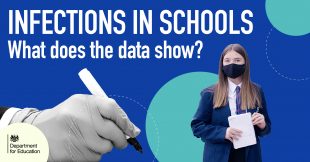
A study has shown the percentage of secondary school age pupils testing positive for COVID-19 has dropped from 1.4% to just 0.3% compared to November last year.
The research, led by Public Health England (PHE), the Office for National Statistics and the London School of Hygiene & Tropical Medicine, tested 7,271 secondary school pupils and 2,744 staff for COVID-19 infection between 15 – 31 March.
Compared to the first two rounds, which used data from schools across 11 local authorities in secondary schools, the study found:
- The percentage of pupils testing positive (0.33%) was significantly lower than in Round 1 (1.42%) and lower than Round 2 (1.22%); and
- The percentage of staff testing positive (0.32%) was significantly lower than in Round 1 (1.36%) and lower than Round 2 (1.64%).
Dr Shamez Ladhani, Consultant Paediatrician at PHE and the study’s chief investigator, said:
Results of this study shows current COVID-19 infection among secondary school staff and pupils has fallen significantly from the already low levels recorded last November.
These findings are reassuring and contribute to wider evidence that shows the risk of transmission in schools is low.
This also indicates the importance of public health measures in schools for reducing transmission.
Hugely encouraging to see positive cases of COVID-19 continuing to remain low among secondary school pupils and staff.
Thank you to staff and pupils for your efforts. Please continue to test regularly and follow protective measures to keep classrooms as safe as possible. https://t.co/nmZ0ZQHt7j
— Sir Gavin Williamson MP (@GavinWilliamson) May 4, 2021
The Department continues to ask teachers and school staff, secondary school pupils and college students, and the households of pupils in school and college (including family members, childcare and people in support bubbles) to take covid tests twice a week.
We have developed some useful links on home testing - for translated self-test guidance on how to self-test, please see here.
The additional safety measures that were put in place before the Easter break also remain. These include face coverings, staggered starts and breaks, desks facing forwards, additional hygiene, and ventilation.